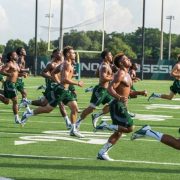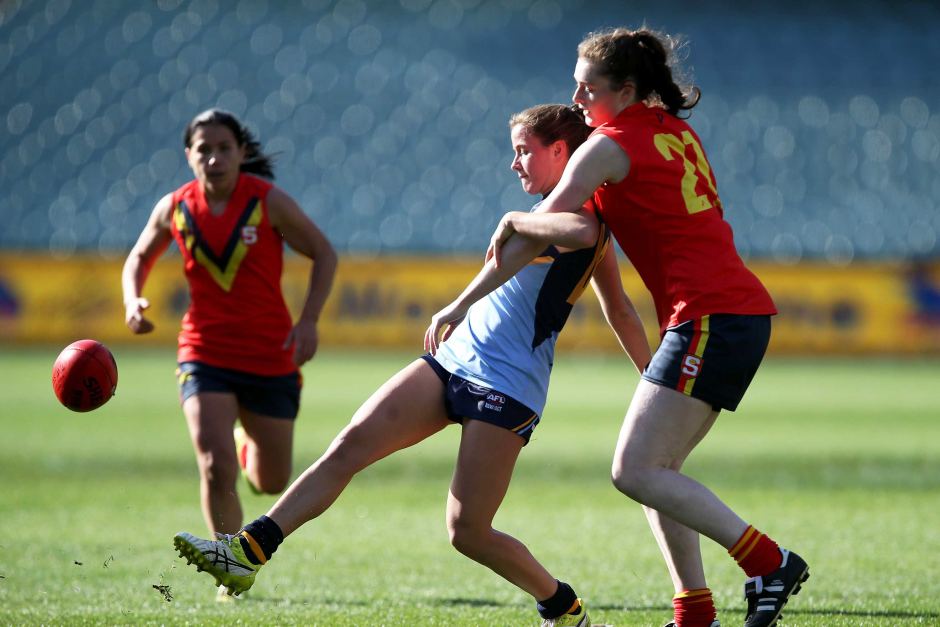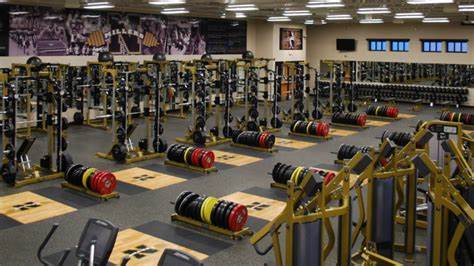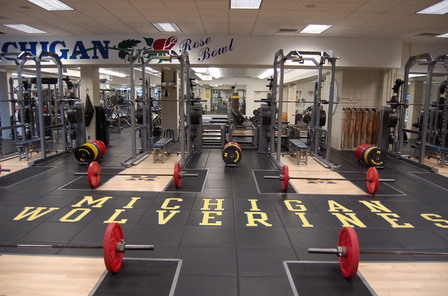Australian Development V American Development
I can’t help but look on in envy at the American system – from high school development – to college development building on it further – to the professional sphere. And when I say this, I talk more about American football (the clearest comparable sport to our game with being single country, a football code etc.) Basketball and soccer for example are more global. Additionally, basketball to a certain extent is also based around the American system anyway (from college level onwards).
I envy the quality of the development that the juniors arrive at, at each level, and in particular the physical level that they arrive at when making it to a professional roster. Specifically, when a guy gets drafted to the NFL, he is not necessarily a ‘finished product’ (although in professional sport, how often is any athlete ever a ‘finished’ product – they are always looking to improve). However, they arrive ‘ready’ physically. Sure, more physical improvement will come, but they are ready to play – ready to go, and ready to contribute.

That most certainly isn’t the case here – barring some very rare exceptions.
I have often heard professional clubs here talk about the under-development of the players who arrive in the AFL system. Indeed I have seen for several years what level they are at in the SANFL physically when we send off the ‘elite’ juniors to the draft. But it was only once I was an intern at an AFL club and was among the daily workings within their system, that I saw first-hand the gap physically between where they are and where they need to be. And more specifically, the enormous juggling act (for high performance staff) between developing them without overloading them too much, whilst simultaneously trying to work them into as much of the senior squad stuff as possible. That is before we even consider playing games. There is far more to it then simply ‘bulking these kids up over the summer’ as many media commentators and fans alike still believe. Not only is this basically impossible to do whilst juggling the other factors, it is no longer really an aim in itself.
It is crazy – as this is supposed to be an ‘elite’ competition, yet such a large chunk of it and its resources are a de-facto development system, making up for the lack of development that occurs prior. That is not a slight on the junior clubs and coaches – rather this is more a nod to the enormous physical toll that the game at the highest level takes on the body, and the very high athletic level (from BOTH a performance but even more so a robustness/injury resistance point of view) that players are required to get to at AFL level – in order to not only perform, but do so consistently without breaking down. There is such an enormous step to be taken from 18 year old junior, to fully fledged professional. Even the step-up from junior to the rigors of league footy at state level is quite large.


This was something that Loris Bertolacci was talking about nearly 20 years ago. Loris was the first full time ‘fitness’ coach in the AFL, and I love reading over his older articles and view points on AFL and physical development, just as a reminder of how little certain things change, despite all the fancy buzzwords and vernacular. He wrote an article where he touched on a presentation he gave where he said AFL was not an elite competition.
“What I meant was that it was biased young and clubs were forced to continually stock up talent for the future even though that could take 5 to 8 years to provide success. And in the end the AFL is not a development program. It is a cut throat business where winning or giving supporters and stakeholders the hope of success being the NO 1 aim.”
Interestingly enough Loris also identified that the state (SANFL,WAFL,VFL) under 19 competitions should be an under 20 competition and also be more professional. Well not only are they neither under 20 nor more professional, the under 19 age doesn’t even exist anymore (another layer of development lost, possibly as this age is seen as beyond the interest of the AFL and their under 18 agenda). Anyway, if interested, this was his article.
So back to the gap from junior elite to senior elite (and even junior state to senior state). There are 2 primary reasons for this gap;
- The draft age itself/age of the player
- The services provided within the pathway to the juniors
In regards to the draft age, we have already covered he numerous benefits in raising the draft age, to all involved; players, AFL clubs, local/junior clubs, and even supporters, elsewhere. More than once.
We also looked at an alternative idea, assuming the draft age of 18 year olds remained, of giving draftees 4 year minimum contracts, allowing clubs to essentially dedicate 2 years to building them physically, layer upon layer, before transitioning into games.
But assuming 18 remains the draft age of choice, and assuming a 4-year minimum contract is too much to ask (not completely against the realms of possibility with growing player power however), the other option is to focus on a development pathway that has young players better prepared when they arrive.
So what are the options???;
School PE. Bring back the ‘physical’ in physical education. Good luck. Unfortunately this appears irreversible given societal trends. This is something that Kelvin Giles has been banging on about for years, and has continued to fall on deaf ears. First physical education became games based. Then it became an elective (at progressively lower years), or at a minimum – easy to get out of participating in the class on any given day. And then somewhere along the way, someone decided that PE should be an academic subject as well. I wont go on any more, this could get very long winded – but check out Kelvin Giles discussions here. Suffice to say, if you think ‘physical’ education is going to help us, think again.
More Physical social activity
Once again – we are harping back to the dark ages. Can you imagine kids, adolescents and teenagers spending their free time playing outdoors, running up hills, riding bikes, making randomly designed physical contests, throwing rocks, getting themselves dirty outdoors with any number of things (or being allowed to out of safety fears from parents)?
That ship has sailed. It isn’t coming back.
Societal norms have dictated that young people don’t do these anymore. They have technology. And their parents have increasing concerns about their safety.
This is another area of incidental physical development – that would have been occurring every single day for years on end – all while the kids and teenagers didn’t notice it because they were having FUN – that doesn’t exist anymore. And it wont again. So we need to find somewhere else to make this up. Lets keep looking…..
Junior clubs and Teams
Unfortunately (sadly really), formal sport commitments are increasingly becoming the only real physical activity and development that juniors are getting these days. As a result, more and more responsibility is falling on these teams an coaches to physically develop juniors, as well as coach them in football (I’m talking u/8’s all the way up to senior broadly.)
So then the inference here is that the whole way up the pathway, it is within this environment that training should place a greater emphasis on the physical development as well as the footy specific stuff. However, I must say I don’t necessarily think this is the way either, as there are some major flaws with this model.
Firstly, kids go out to footy training to play football – right the way through the ages. Even as they hit their early teens and start to become more aware of the physical development aspect of it, football training should still be largely about football. Something Kelvin Giles (the great man again) has discussed is that the coaching licenses/badges for sports including basic movement competency skills, so that junior coaches can throw in 5-10 minute ‘movement’ blocks in between sports specific skills. However whilst I agree that some general education of junior coaches in this way is certainly a positive, and there is room to throw in little movement tasks into sessions, there is still very limited time available in that 1.5 hour training, 1 night per week.

A second issue – more so as the juniors get older and more physically advanced – is the issue of available facilities. When you are working with 10 year olds, equipment required is minimal. In fact when you are working with a group of 15 year olds who can’t do a proper push up, the equipment required is still minimal – as they have no right to add external load with barbells while they can’t master their own bodyweight. But when you have a group of juniors who largely have a reasonable level of physical competency, and need a specific stimulus, facilities becomes the issue. Specifically, an indoor facility, with enough space for a group of say 15 players at a time, as well as the expertise to run a session in that facility.
How many junior/local clubs have either of these? Its not realistic, particularly in the current climate, where funds are going to be as tight as ever – especially if players in the A-Grade at that club still expect to be paid.
Even in the junior elite pathway – (SANFL, WAFL, etc) - and even higher in the state squads (or ‘AFL academy’) – there is VERY little time for things such as gym training. Gym facilities at most SANFL clubs (the example that I have seen firs hand – but it appears the same in every state) struggle to accommodate for junior teams, especially when they are juggling the senior squads and womens squads too. There is normally one S&C coach, who does the best they can with the limited time that is available, but in the end, the result is very little actual development in that formal training time. Additionally, there is only so much evening time that juniors can be expected to dedicate, when they already have several night taken up with footy, plus the homework, plus work for those who have part time jobs.
And back to the AFL academy - when a kid gets to state under 18 level, they already have the majority of their developmental years behind them.
So in summary of this, even at the junior elite football path, it is VERY limited and VERY hard to make physical development much of a focus.
In summary - the options for development are limited.
In order to make genuine development or improvement in this area – and have 17 and 18 year olds who are better prepared for the physical rigours of senior footy – at any level – but especially in the higher levels of the game - We require;
Time - say 2-3 sessions/days per week where it is a focus
Consistency – most weeks of the year, not a 4-week block, once a year!
Building on it in layers – year upon year – once again, not a one off year!
General, rather than anything ‘specific’ – broad athletic development – all the ‘specific’ stuff they get in football training.
What we require and what will go a long way to filling this gap is something that kind of resembles what physical education was 30-40 years ago, but perhaps just little more professional.
We require a solution that doesn’t pile on more after school commitments to these juniors in the process, and still leaves them with time availability.
A sector where the money and facilities (space the main thing) to host it are there, or could realistically be there without too much of a hassle.
This is nothing groundbreaking – we only need to look at the example set by our friends in the United States (and their vastly superior junior development opportunities provided). I am of course speaking of strength and conditioning/athletic development (a much better and well rounded description) – in the high school setting.



 Down here in Australia, our jaws drop when we look at the facilities that these colleges have at their disposal.....
Down here in Australia, our jaws drop when we look at the facilities that these colleges have at their disposal.....
Only to realise that these are actually High Schools!!!
And this is something that we will delve into in great detail, into exactly why this is the ideal place to fill this gap, and then exactly what sort of ways this could be approached. Some schools have already started to sort of give this a go – but for a majority of schools and certainly parents, the majority have never really even thought of it, or understand how to do it, and why to even bother.
So we will look at this in more detail next time.
If you would like more detailed and personalised direction, checkout our personalised online programming, or if you would prefer even more personalised and detailed in-person coaching (for those lucky enough to live in the beautiful city of Adelaide), check out our Athletic Development Coaching and Junior Athletic Development Coaching.

